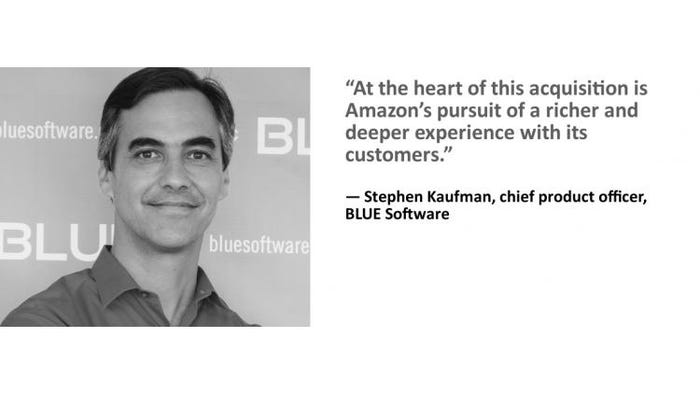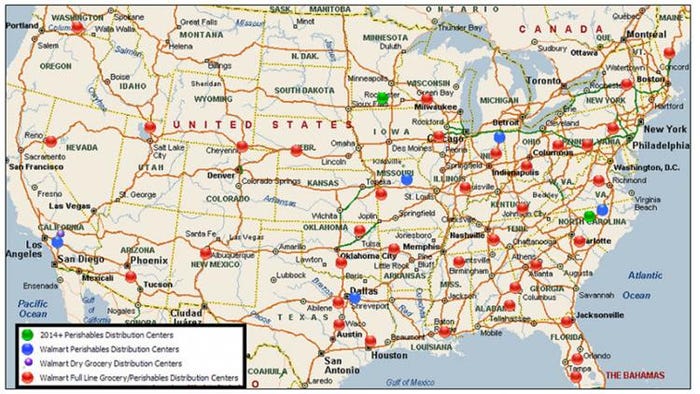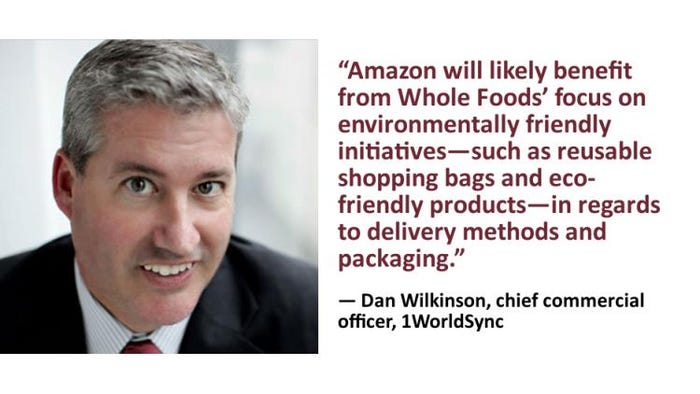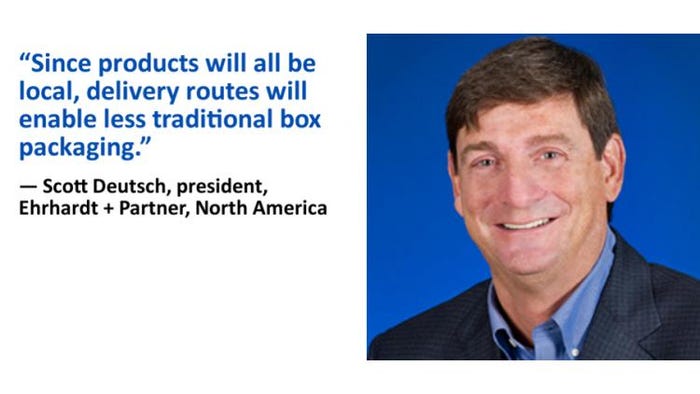What Amazon buying Whole Foods might do for ecommerce packaging
A game changer. That’s what ecommerce and business experts are calling Amazon’s recently announced acquisition of Whole Foods. Amazon has already been leading in ecommerce packaging, especially for durable goods. How will this venture change the retail landscape, especially for fresh foods and beverages? And what might it mean for product packaging?
Packaging Digest asked a trio of analysts (see their bios at the end of the article) for their opinion on the deal and its probable packaging impacts:
• Scott Deutsch is the president of Ehrhardt + Partner, North America, a global provider of warehouse management systems (WMS)/warehouse control systems (WCS)/voice solutions.
• Stephen Kaufman, is the chief product officer of BLUE Software, a label and artwork management solutions provider.
• Dan Wilkinson is chief commercial officer of 1WorldSync, a multi-enterprise, global product information network with offices in the Americas, Asia Pacific and Europe.
Dan, you’ve said you think this acquisition of a trusted grocery partner could place Amazon as the clear market leader in e-grocery. Why is that so important?
Wilkinson: Trust has been one of the biggest barriers for the grocery industry in the shift online. Historically, consumers have been adamant in their desire to touch and feel a perishable food item before purchasing it, and only in the last couple of years have organizations been able to slowly gain consumer trust to purchase perishables online.
Whole Foods’ has built its brand on a reputation of trust, using its organic-only products and detailed product content approach to drive loyalty with its customers. With this acquisition, Amazon absorbs that reputation of trust and gains access to Whole Foods’ loyal customer base. Other retailers in the online grocery industry have struggled with this, including Amazon, due to its position as a marketplace, not a pure-play retailer.
Along with Whole Foods’ brand reputation, Amazon gains 431 new fulfillment and distribution centers across the nation, giving them greater power to improve fulfillment of grocery products and improve trust to acquire new grocery customers. With Whole Foods’ brick-and-mortar stores and Amazon’s powerful ecommerce technology, the company has effectively solved the last-mile fulfillment barrier that has prevented widespread consumer and retailer adoption of omni-channel grocery.
Industry experts have speculated that Amazon’s purchase of Whole Foods is a strategic way of expanding Amazon’s distribution of fresh foods bought through ecommerce. What do you think and why?
Kaufman: Amazon’s purchase of Whole Foods might indeed be a method for expansion of fresh foods distribution, but the move goes much farther than that.
At the heart of this acquisition is Amazon’s pursuit of a richer and deeper experience with its customers.

You can only develop so much of a relationship with a web page and a box. The consumer is looking for engagement that can best be served in a crafted environment like a store. Much like Apple, Amazon realizes that a store can become an emotional destination, and Whole Foods already has developed this type of relationship with shoppers: 460 stores in the U.S., Canada and the United Kingdom, and $14 billion is more than an experiment.
Amazon also realizes that eventually Walmart and others will catch up with online retailing; Amazon wants to move into Walmart’s space to make it defend its home turf.
Add to this notion the idea that Millennials are increasingly more aware of where food (and especially fresh food) is sourced. Whole Foods’ supply chains only span a few counties for some products based on “buy local” sentiments. Amazon will find a way to bind these micro-chains to online fresh shopping, while simultaneously leveraging the in-store experience with the same consumer.
Expect to see a new blended experience between online and retail where online orders can be picked up at Whole Foods, and items ordered and purchased at Whole Foods can be delivered through Amazon’s growing delivery network. Shop with your friends, go to a movie and have all your groceries arrive tomorrow morning at your respective homes.
All makes for interesting and compelling combinations.
Wilkinson: I have no doubt that this was a strategic move by Amazon to improve its ability to sell fresh foods online. The two barriers that Amazon need to get over to penetrate this market were consumer trust and fulfillment. They solved both by buying Whole Foods.
Amazon is now in the position to leverage Whole Foods’ 431 existing stores across the U.S., which gives them valuable fulfillment centers in highly populated areas and the ability to distribute fresh food quickly and reliably. Amazon could also use these stores as additional touchpoints if they wanted to sell other product categories outside of food in Whole Foods locations.
Additionally, Amazon can now leverage Whole Foods’ reputation for trust and authenticity, which has been a key driver in Whole Foods’ ability to grow and maintain such a loyal customer base. Amazon’s choice to purchase Whole Foods instead of another grocery chain was strategic—it saw the necessity of consumer confidence in the food industry and chose the most trusted grocery chain on the market to help it grow its online grocery presence.
Deutsch: I believe the strategic value in making the acquisition of Whole Foods by Amazon is really about building out its “local operational distribution model” to effectively compete with Walmart. Whole Foods is its “testing playground” to learn how to address the complex frozen and chilled grocery offerings.
In Whole Foods, Amazon obtains a high-end grocery chain with actually a limited market footprint, but room probably for greater operating efficiencies and thus the potential for lower and more competitive market pricing. When you compare the market footprint of Walmart’s 150+ distribution centers to the 11 distribution centers of Whole Foods, the scale of an Amazon/Whole Foods just does not compete effectively with Walmart.

Map shows the location of Walmart’s 150+ distribution centers in the U.S. Source: MWPVL Intl.
NEXT: The packaging implications?
What might be some of the packaging implications of this? Might we see Amazon investing in more returnable packaging rather than one-way/disposable packages?
Kaufman: We don’t really see returnable packaging as a driver or even a major factor in this acquisition. Returnable packaging at the single consumer unit level is expensive, impractical and potentially unsanitary. The idea goes back to the days of the 5-cent returnable Coke bottle; for a single glass container, which is not porous and relatively easy to wash and reuse, there was still only moderate adoption. And many returnables were more about reducing finished beverage litter than reuse of materials. Five-gallon water bottles can be refilled and reused, but few do so today.
Packaging is about consumption convenience and product advertising and we believe that returnable packaging will be little more than a novelty for some time to come.
Wilkinson: Amazon will likely benefit from Whole Foods’ focus on environmentally friendly initiatives—such as reusable shopping bags and eco-friendly products—in regards to delivery methods and packaging. It would also be a logical next step to use the Whole Foods stores as fulfillment and distribution centers, thus reducing a need for alternative packaging methods since products won’t have to travel far distances.

Deutsch: As Amazon and others explore new markets, such as groceries, they all will be confronted with consumer expectations. When you think about how dry goods are shipped today, the plain logoed boxes have optimized for traditional shipping approaches. However, this may not be the case for the grocery market.
If you look at Blue Apron’s delivery approach, it’s relatively traditional. It ships overnight in a standard container, just with dry ice. I would not be surprised to see Amazon and Walmart challenge the status quo by providing sturdier bag packaging for same day shipping. I expect this would be possible because the shipping vehicle would likely be staged differently than how they ship product today.
I do not expect returnable packaging to be an initial option, strictly due to the logistical challenge, but would expect to see by 2020 a greener option available. The packaging cost will become an important cost component once sufficient consumer stickiness and scale has been achieved.
How might this change the future of online grocery sales?
Wilkinson: The acquisition places further importance on cross-channel commerce in the grocery space. Consumers need to be met where they are, whether that’s in store or on their smartphones. A streamlined omni-channel approach to e-grocery will be crucial for competitors moving forward, with an increasing focus on the intersection of physical and digital.
Online grocery initially developed slowly, as consumers had a strong desire to touch and feel grocery products before purchasing. However, with Whole Foods’ trusted brand reputation, Amazon customers can feel comfort in purchasing organic, GMO-free, high-quality food online.
NEXT: Location, location, location
Even with products shipping closer to where the consumer/buyer lives, Amazon would still have to ensure fresh foods are kept at the right temperature throughout distribution. What new packaging/shipping options might Amazon have now with the acquisition of Whole Foods?
Kaufman: Amazon, in its soul, is a technology company. The “Amazon Go” store showed that Amazon is thinking carefully about the use of technology in and around the retail shopping experience. Couple this pattern with the explosion of options provided by the Internet of Things (IoT).
Inexpensive environment monitors can be added to shipping crates so that Amazon can have data from “store to door” regarding in-transit humidity, temperature, direct sunlight, barometric pressure, and even radiation and exposure to noxious chemicals. These technologies will help ensure that delivered fresh food is safe and has been reliably transported.
In fact, Amazon could likely provide that environmental transit data back to the consumer through its shopping portal. It’s likely that Amazon already knows these basic environmental trends relative to transportation methods, and understands better than the rest of us that local redistribution from a Whole Foods store is a better bet than regional/urban fresh delivery.
In any event, Amazon will have the data to offer the consumer the best choices, and will evolve quality through data analytics and process genius.
Wilkinson: Amazon now has access to more than 430 Whole Foods stores located in urban and high population density areas. Amazon will be closer to the consumers it’s trying to reach, and may be able to circumvent creating new packaging and shipping options because the delivery distance is much shorter.
Deutsch: The last mile is where Walmart is staging the next battle ground by planning to leverage it’s more than 1 million workers who work at a Walmart store, which is within 10 miles of 90% of the population. So for Walmart, its approach will bypass the added logistical layer.
For Amazon, I expect it to eventually design a custom vehicle, similar to what the United States Postal Service (USPS) has done. These branded vehicles will account for dry, chilled and frozen goods.
Since products will all be local, delivery routes will enable less traditional box packaging. Consumers would be quite comfortable with the same shopping experience they are familiar with of the grocery bag. These bags would provide greater cross-selling opportunities by using the bag real estate for advertising and promotional benefits.

OUR ANALYSTS
• Scott Deutsch is the president of Ehrhardt + Partner, North America, a global WMS/WCS/voice solutions provider with more than 500 team members and 1,000+ customers. Previously, he was the director of global marketing communications at Honeywell Sensing & Productivity Solutions and helped the business transition successfully to a connected Internet of Things (IoT) world. His expertise is in the areas of developing successful communications and defendable positioning strategies. Deutsch has extensive experience in helping take early stage companies to expansive levels of growth and profitability.
• Stephen Kaufman, chief product officer of BLUE Software, is an industry-recognized thought leader and visionary. The former chief technology officer (CTO) of SHAWK! SGK, Kaufman brings both a unique vision and leadership skills honed over the course of 20 years in the Label and Artwork Management and pre-media industries to BLUE. His goal is to gain an ever-deepening understanding of BLUE customers’ future needs to enable BLUE to sustain its role as the technology leader in the next generation of solutions.
• Dan Wilkinson, chief commercial officer of 1WorldSync, brings more than 20 years of strategic business development and general management experience to 1WorldSync. Wilkinson plays a key part in developing the company’s strategic direction, and is responsible for ensuring that clients derive maximum value from its services and solutions.
ADDITIONAL INSIGHTS
Many business experts are analyzing what Amazon’s recent move might portend. Here are links to some of the news reports to help put this transaction in overall perspective:
CBX Experts: Amazon's Whole Foods Acquisition is a Big Deal Indeed
Amazon Purchases Whole Foods: The Global Context
What Amazon’s Purchase of Whole Foods Really Means
Analysts react to Amazon’s $13.7B deal for Whole Foods
America is over-malled, but not enough warehouses to support Amazon
Amazon Robots Poised to Revamp How Whole Foods Runs Warehouses
Amazon to Buy Whole Foods for $13.4 Billion
Amazon is buying Whole Foods for $13.7 billion
There's a reason the grocery industry is panicking about Amazon's purchase of Whole Foods
About the Author(s)
You May Also Like




